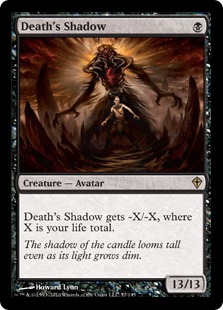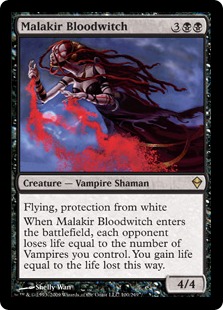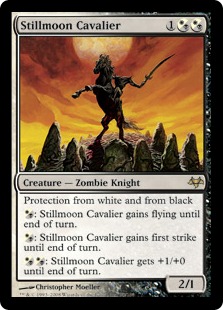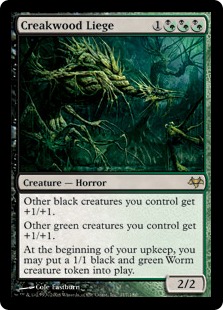
Introduction:
Every color in magic has a core set of cards that make it shine: Red has Lightning Bolt and friends, Blue has cantrips and Force of Will, and so on. However, to this happy fact there is a hitch: many of these core cards tend to beat up your bank account something awful. Green's Tarmogoyf, Blue's Jace, the Mindsculptor... any budget player is gonna have a hard time paying for their services.
Yet, fear not--there is a color whose core set of cards is both extremely powerful and extremely cheap. This color is Black.
Ever since Magic’s inception, the color black has had some of the most powerful cards at its disposal. When Magic was young, black had the best mana acceleration, the most aggressive creatures, and some of the best disruption and removal in the game. Today, not much has changed; a good lot of those original cards are still used and, extraordinarily, they cost little to nothing in today’s market.
An example? Dark Ritual. Arguably the best non-power-nine mana accelerator in the game, it can be found for cents on the dollar. And Dark Ritual is just the beginning; it is only a part of the real core of Black. This core has three parts: one, the discard spells (think Duress, Inquisition of Kozilek, and Hymn to Tourach); two, the two-cost creature destruction spells (such as Smother and Go for the Throat); and three, mana acceleration (e.g. Dark Ritual and Cabal Ritual). Each of these spell categories work wonders in almost any mono-black deck, by filling multiple roles, providing a strong backbone to most strategies, and by freeing up your budget--kind of like an army of zombies set to do your bidding. They don't complain, they don't form unions and ask for dental, they just kill stuff at little to no cost to you.
And so, because of this satisfying image, every deck presented here will use most, if not all, of these core cards, which just proves not only their power, but also their versatility.
Smother is my favorite of the two-cost removal spells, as the vast majority of creatures in Legacy die to it. This is especially true with the advent of Delver and similar cards and strategies. It is because of this that any list presented in this article that runs a two-cost removal spell will be running Smother as that spell. One other card that you will also see often in this article is Umezawa's Jitte. Jitte is a card that screams to be played in many of Black's strategies, and with good reason. Jitte is a card that is just so powerful and versatile that it can make or break games by itself.
That said, let's break out the decks! (And leave Jace and Tarmogoyf to the zombies.)
The Decks:
Not many people have heard of this combo deck, as it has had little mainstream recognition. Regardless, it's as much fun as a full-throttle Plunge into Darkness, which is probably because it uses Plunge into Darkness.
Deck Name: Tainted Shadow
Deck Type: Combo
Cost: 125
| Tainted ShadowMagic OnlineOCTGN2ApprenticeBuy These Cards | |
|---|---|
|
Creatures-12 4 Death's Shadow 4 Phyrexian Obliterator 4 Spellskite Spells-33 2 Aphotic Wisps 2 Chrome Mox 4 Dark Ritual 4 Duress 4 Inquisition of Kozilek 4 Lotus Petal 4 Plunge into Darkness 1 Slaughter Pact 4 Spoils of the Vault 4 Tainted Strike | Lands-15 15 Swamp |
Key Interactions-
Death's Shadow + Tainted Strike or Spellskite or Aphotic Wisps or Plunge into Darkness or Spoils of the Vault
An all-in combo to end all other all-in combos, Tainted Shadow is a mono-black re-imagining of the Suicide Shadow deck that Brad Strickman piloted at a Legacy SCG earlier this year. His version of the deck splashed green and focused on the interaction between paying life with search cards like Plunge Into Darkness--which makes Death's Shadow bigger--and then casting

Your opening turns normally consist of setting up the combo with cards like Plunge Into Darkness or Spoils of the Vault, which search for whatever pieces you may be missing. You could also spend them clearing the way for the combo with discard spells like Duress and the protective creature Spellskite. Dark Ritual, Chrome Mox, and Lotus Petal all ensure a blazing fast attack--not to mention the ability to cast multiple key cards in the opening turns of the game.
One of the most interesting interactions of Tainted Shadow comes from Spellskite. The ability of the Horror does require a legal target in order to activate, but every spell in the game is a legal target. It does not matter if the spell targets or not. If it doesn't, Spellskite's ability will merely fizzle. That's okay though, since all you really want is to be able to pay two life multiple times on the Death's Shadow you just cast, so that when it hits the field you have lost enough life to make it a major threat. Of course, Spellskite can also be used to protect your Shadow from removal.
Plunge into Darkness and Spoils of the Vault can search for silver bullet style cards like Aphotic Wisps--to ignore any blockers that may keep shade from getting through--or Slaughter Pact, to get rid of any hate bears. Finally, Phyrexian Obliterator serves as the alternate win condition of the deck. Dark Ritual lets you cast him on turn two, and your discard, combined with Spellskite, protect him enough for you to ride him to victory. If your opponent blocks him, they regret it instantly--and if they manage to answer him, you should have been given plenty of time to sculpt your actual combo and respond by finishing off the block-happy little boogers.
Of course, the mere style of this deck causes it to come with a decent amount of risk. Any life-pay deck is all-or-nothing, after all. But what can beat casting the Shadow of Death over your opponent?
Deck Name: Vampires
Deck Type: Aggro
Cost: 130
Next in the line-up tonight is a good old-fashioned coven of Vampires. Like most vampires, these guys do not sparkle, yet people assume that they do, so they are thoroughly underestimated as a result. Just have faith in these slick hickie-lovers, and you're sure to see blood.
| Legacy VampiresMagic OnlineOCTGN2ApprenticeBuy These Cards | ||
|---|---|---|
|
Creatures-24 4 Bloodghast 4 Gatekeeper of Malakir 4 Kalastria Highborn 4 Vampire Nighthawk 4 Viscera Seer 3 Bloodline Keeper 1 Malakir Bloodwitch | Spells-16 4 Cabal Therapy 4 Hymn to Tourach 4 Smother 2 Umezawa's Jitte | Lands [22] 20 Swamp 2 Undiscovered Paradise |
Key Interactions-
Bloodghast + Undiscovered Paradise or Kalastria Highborn or Viscera Seer or Cabal Therapy or Bloodline Keeper
Bloodline Keeper + Kalastria Highborn or Viscera Seer
While not as aggressive as most of the tribes in magic, this group of bloodsuckers makes up for its inability to finish the game fast by excelling at its ability to grind out your opponents through card advantage and field control cards. The most useful card in the deck--and the most cool-sounding--is Bloodghast. Every time a land hits play this guy comes back from the dead with a vendetta against your opponent's life total. And yet, he is so much more than a recurring attacker; combine him with Kalastria Highborn and/or Viscera Seer, and you have a nice little recurring damage engine that also manipulates your draws for you (kind of like a vampire who can break out of his coffin, turn into a bat, and spawn more vampires, among other things). Yet his versatility does not stop there: Cabal Therapy works dark miracles with him, allowing you to use the same discard spell multiple times, generating insane card advantage. But let's not forget Undiscovered Paradise, Bloodghast's best friend. It allows you to recur him every single turn. It does limit your land count though, decreasing tempo, so be careful when using this combo.

Now, the absence of any real lords or buffs makes creatures like Tarmogoyf and Knight of the Reliquary kind of scary for all of your 2/2's. But donnnn't vooorry (that's Dracula for "don't worry"): if there is anything black is good at, it's getting rid of creatures. Gatekeeper of Malakir and Smother both do the job pretty well for anything that hits the field, and Cabal Therapy and Hymn to Tourach clear their hand of potential threats as well. Umezawa's Jitte also does this job, along with a million others. It's Jitte. It's good. Get used to seeing it.
Vampires really excels at any control match-ups, as the recursion of Bloodghast and constant production of threats with Keeper--combined with discard--really gives them a hard time. That being said, the real nail in the coffin for such a match is Malakir Bloodwitch. Protection from white makes Swords to Plowshares worthless for them, and her come-into-play ability really helps as well, decreasing the needed clock and giving you back any life you may have lost along the way. The Bloodwitch really is not a card to take lightly, and is one of the reasons this deck exists.
Deck Name: Black Weenies
Deck Type: Aggro
Cost: 170
Weenie decks are nothing new to Magic players, but this version of Black Weenies breaks the mold with its unique creature suite and battle plan.
| Black WeeniesMagic OnlineOCTGN2ApprenticeBuy These Cards | ||
|---|---|---|
|
Creatures-15 4 Stillmoon Cavalier 4 Stromgald Crusader 4 Vampire Nighthawk 3 Hypnotic Specter 2 Big Game Hunter | Spells-25 4 Dark Ritual 4 Duress 4 Hymn to Tourach 4 Smother 3 Æther Vial 3 Umezawa's Jitte 1 Sword of Feast and Famine | Lands-20 20 Swamp |
Key Interactions-
Æther Vial + Stillmoon Cavalier or Stromgald Crusader or Big Game Hunter or Vampire Nighthawk
Dark Ritual or Sword of Feast and Famine + Stillmoon Cavalier or Stromgald Crusader
Unlike most Black Weenie decks, this particular build concentrates much less on one-drop creatures and more so on the immense power that comes from loading evasive and pro-white creatures with equipment. With Swords to Plowshares out of the equation, Umezawa's Jitte becomes an even better card than it already was.
Stillmoon Cavalier and Stromgald Crusader are the main pieces of this deck. Protection from white on a body that can fly, get first strike, or buff itself is the perfect place to lay an equipment. Of course, all of these things cost mana, making these guys very high maintenance. That's where Æther Vial comes into play. Æther Vial allows you to spend all your mana on the power up abilities of your guys and the equip costs of your swords while still playing more guys. Dark Ritual is more or less the same thing. It speeds out your creatures, pays for equip costs, or just goes into the fire-breathing style abilities of your knights, guaranteeing that it is never a dead top-deck like it is in many other decks.

This style of black weenie deck works wonders against mid-range builds like U/W or Esper Stoneblade, and can do pretty well against creature strategies like Maverick as well. Its main weakness, however, is Burn (a big weakness of any weenie, if you ask me). None of the creatures are really protected from any Lightning Bolt-style cards, and their low defense makes it hurt. Jitte can also hurt you. An opponents' active Jitte will clear your field faster than you can blink. Of course, the fact that you run three of your own means that you can take advantage of the Legendary rule and blow up any Jitte you are afraid of, simply by casting your own. If you can get past these weaknesses, this unique and updated version of a golden oldie should really do some damage for you.
Deck Name: Demon Stompy
Deck Type: Aggro
Cost: 210
My favorite deck out of the decks presented this week, this is the black version of the "Stompy" Legacy decks you may have heard of. With a name like Demon Stompy, you can't help but try it out.
| Demon StompyMagic OnlineOCTGN2ApprenticeBuy These Cards | ||
|---|---|---|
|
Creatures-18 4 Demonic Taskmaster 4 Phyrexian Rager 4 Plague Spitter 4 Shriekmaw 2 Graveborn Muse | Spells-24 4 Chimeric Idol 4 Chalice of the Void 4 Chrome Mox 4 Dark Ritual 3 Trinisphere 3 Umezawa's Jitte 2 Tribute to Hunger | Lands-18 14 Swamp 4 Ancient Tomb |
Key Interactions-
Chimeric Idol + Plague Spitter or Demonic Taskmaster
Made possible by the recent release of Demonic Taskmaster, Demon Stompy plays out just like every other Stompy deck in the format--with a few twists here and there. Using your mana acceleration of Chrome Mox, Dark Ritual, and Ancient Tomb, power out an early Chalice of the Void or Trinisphere and bring the hurt on, demon-style.
Demonic Taskmaster serves as your main beater and works wonders with Umezawa's Jitte. Following him are your utility

Chimeric Idol combos well with Demonic Taskmaster, as he allows you to actually have multiple creatures to beat with, even when Taskmaster makes you sacrifice your guys. The interaction with Plague Spitter, while not as nice is also pretty cool, as you don't have to worry about your Idol taking damage from him.
Umezawa's Jitte does what it does best: it pokes your threats full of holes, and fills up your own, giving you more life after you lost it to your Tombs and Spitters. The count of three lets you enter a match with the confidence that you will see it at least once, and you don't have to worry if you need to Legendary-rule an opposing Jitte away. Tribute to Hunger serves a similar purpose by getting rid of threats and blockers, and by gaining back some life lost through your acceleration. Sometimes, you have to feed your inner demon, and this deck is a good way to do that.
Deck Name: Contamination Station
Deck Type: Control
Cost: 220
Our final deck of the night is a more expensive version of one that I have written about before. Because of the overwhelming response to the $100 version of this Contamination deck (circa Super Budget Super Series 1), I figured you guys would like it if I slogged up a more expensive, more dangerous, and more diseased version--for you all to, ahem, enjoy. Bring on the disease!
| Contamination StationMagic OnlineOCTGN2ApprenticeBuy These Cards | |
|---|---|
|
Creatures-3 2 Nether Spirit 1 Creakwood Liege Spells-32 4 Liliana of the Veil 4 Bitterblossom 4 Contamination 3 Cursed Scroll 2 Inquisition of Kozilek 4 Duress 4 Hymn to Tourach 4 Innocent Blood 2 Geth's Verdict 2 Mutilate | Lands-24 22 Swamp 2 Mishra's Factory |
Key Interactions-
Contamination + Nether Spirit or Creakwood Liege or Bitterblossom
Liliana of the Veil + Cursed Scroll
In case you missed it last time or just plain forgot about it, this deck is called Contamination Pox. The deck works differently from other pox decks by casting Contamination to nullify all the lands your opponents have, instead of using Wasteland or Sinkhole--along with the Pox cards--to kill off their manabase. Nether Spirit, Creakwood Liege, and Bitterblossom all produce a creature every turn, so that Contamination can stay out. They also act as as a win condition for you when the time comes. Any of these cards combined with Contamination usually spell Game Over for the vast majority of Legacy decks, as most can't come back from having all their lands turned to swamps.

This deck handles itself very well in creature-based metagames, a little over one third of the deck is something that can kill or at least infinitely block creature strategies. That being said, it can also hold its own against other control or combo decks through its discard. If you liked the $100 version, then you'll like this one even more. Provided you have a life rope, and can keep from catching the plague, that is. You'll have a lot of bodies to wade through.
Conclusion:
Well I'm sure that by this time the zombie slaves you accumulated have done their job on Jace and Goyf. Whether it be in tandem with Death's Shadow or a Demonic Taskmaster to keep them in line, this article should have at least proven its point to those core cards that are just too expensive for us. Black is a force to respect and in the right meta, or with the right timing, it can come in, fangs out and eyes red, ready to give Jace a run for his money.
Comments